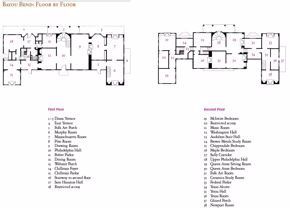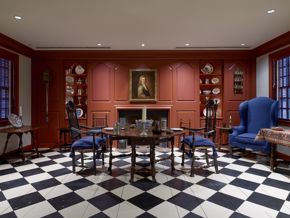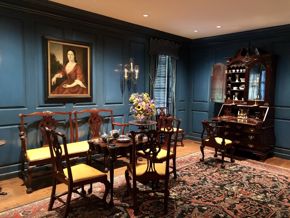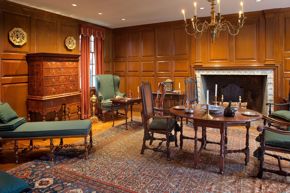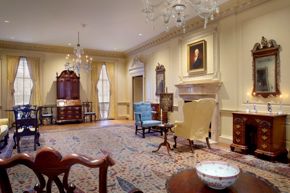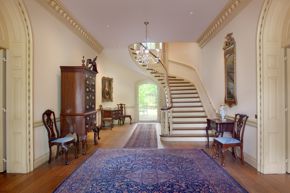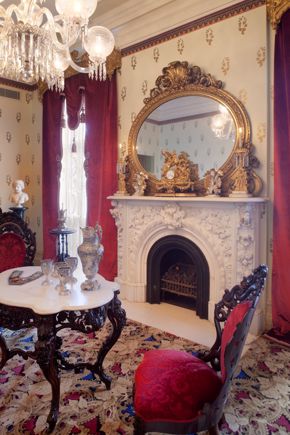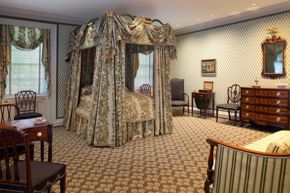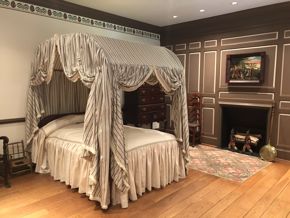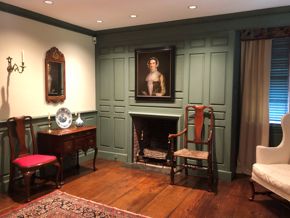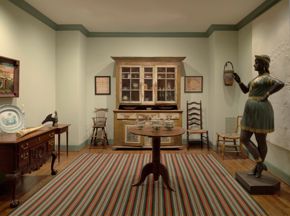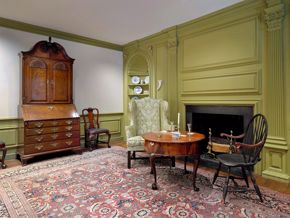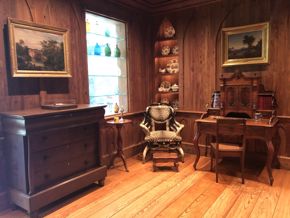Bayou Bend Virtual Tour
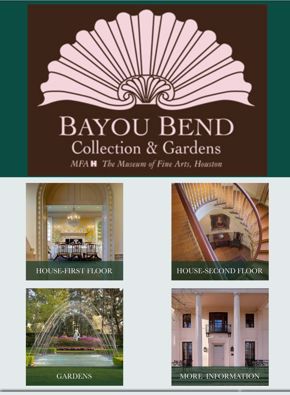
Text BAYOU to 56512 to take your virtual tour of Bayou Bend Collection and Gardens.
Text BAYOU to 56512 to take your virtual tour of Bayou Bend Collection and Gardens.
Text BAYOU to 56512 to take your virtual tour of Bayou Bend Collection and Gardens.
Text BAYOU to 56512 to take your virtual tour of Bayou Bend Collection and Gardens.
When Bayou Bend is closed, you can visit the house and gardens on a virtual tour.
- To take your tour, text BAYOU to 281-918-7855
- Messaging and data rates may apply. To STOP messages, reply STOP.
Your use of Guide by Cell’s services are subject to their respective terms of service and privacy policies.
Period Rooms
In 1957, philanthropist and collector Ima Hogg gave Bayou Bend and her collection to the MFAH. She spent the next nine years transforming the house with room settings that suggest early American interiors from particular periods. In 1966, Bayou Bend opened to the public.
Below is an introduction to each of the themed rooms, which range from the earliest period in colonial American history to just after the American Civil War. The selection of art on view is ever-changing, so stop by to see what’s new in the elegant rooms throughout the house!
Enlarge the image of the map to see the room names and locations, or download a PDF.
First Floor
Murphy Room
Completed in 1959, the Murphy Room was named for Ima Hogg’s friend and fellow collector, Katharine Prentis Murphy, who closely advised on creating the room—the first museum interior at Bayou Bend.
The painted, black-and-white checkerboard floor was inspired by the ones seen in late-17th-century Boston portraits. The art on view in this room includes the oldest objects in the Bayou Bend Collection, from the Late Renaissance (1620–90) and Early Baroque (1690–1730) periods.
Massachusetts Room
The dramatic blue hue of the Massachusetts Room’s walls was inspired by a piece of 18th-century Portuguese chintz, a type of colorful textile. The room’s selection of sophisticated Salem and Boston furniture includes a rare, complete suite of a double chair-backed settee and eight matching side chairs, all upholstered in brilliant yellow wool.
Pine Room
Originally a library, the Pine Room was once lined with floor-to-ceiling bookshelves. When Ima Hogg was preparing the home to become a public museum, she covered the shelves with new pine paneling patterned after mid-18th-century woodwork that she admired in a period room installed at the Metropolitan Museum of Art (now in the Hogg Family Legacy Room at the Lora Jean Kilroy Visitor and Education Center).
Today, the Pine Room displays many objects in the Early Baroque style (1690–1730), including a high chest of drawers made by skilled cabinetmakers and distinguished portraits that retain their original carved frames.
Drawing Room
The largest space in the house, the Drawing Room reflects the Georgian architecture of mid-18th-century American interiors and displays furniture designed in the Rococo style (1755–90). The handsome portraits on view in this room were painted by distinguished early American artists, including John Singleton Copley and Charles Willson Peale
Philadelphia Hall
A 1971 portrait of Ima Hogg presides over the wide central hall that leads to a gracious terrace and to the lush gardens. The Philadelphia Hall borrows its name from the city where its Rococo-style furniture was made.
The hall’s curving staircase may have been inspired by a similar one in the Governor’s Mansion in Austin, where she lived as a child when her father, James Stephen Hogg, served as governor from 1891 to 1895. She and her brothers would sometimes slide down the banister for fun, and when her youngest brother, Tom, broke his arm doing so, Governor Hogg hammered nails down the banister to discourage their games!
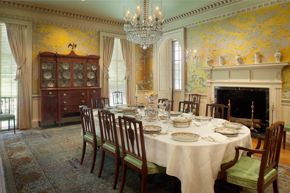
The Dining Room at Bayou Bend Collection and Gardens.
The shimmering, gold-leaf canvas wall covering in Bayou Bend’s Dining Room features hand-painted peonies, Texas dogwood branches, and garden creatures.
Dining Room
Rooms specially designated for dining did not exist in the United States until after the American Revolution. Even then, only the wealthy could afford the rooms since they required new, extravagant furniture forms such as the sideboard, which was used for displaying and storing tableware.
The Dining Room’s shimmering, gold-leaf canvas wall covering, designed in 1927–28 by New York artist William MacKay, is hand painted with peonies, Texas dogwood branches, and garden creatures such as field mice and butterflies.
Chillman Suite
The Chillman Suite, which includes a foyer and parlor, is named in honor of interior decorator Dorothy Dawes Chillman—wife of James H. Chillman, Jr., the first director of the Museum—who helped Ima Hogg develop Bayou Bend’s period rooms during the 1950s and 1960s.
With vibrant greens and golds, the Chillman Suite brings to life the classical taste so popular in the United States in the first half of the 19th century. The wall-to-wall carpeting was reproduced from a period example. Details of the objects on view evoke classical forms.
Belter Parlor
The furnishings in the Belter Parlor reflect the Rococo Revival style (1845–70). The parlor takes its name from John Henry Belter, a cabinetmaker who was a leading manufacturer in New York City during the 1850s. Belter’s factory made the matching set of furniture that is on view in the room.
In 1971, Ima Hogg completed the Belter Parlor, the last of her room installations. The furnishings reflect a strict adherence to historical accuracy; the wallpaper is based on fragments of French wallpaper used at a home in Salisbury, Connecticut, and the carpet is a reproduction of an English design from the Rococo Revival period.
Second Floor
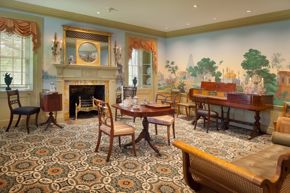
The Music Room at Bayou Bend Collection and Gardens.
The centerpiece of Bayou Bend’s Music Room is the Square Piano by Gibson & Davis.
Music Room
The Music Room reflects an important interest of Ima Hogg, who was an accomplished pianist as well as a founder of the Houston Symphony. The room’s centerpiece is the exquisite Square Piano by Gibson & Davis.
Scenic wallpapers were popular with wealthy Americans in the late 18th and early 19th centuries. Installed in 1993, the example that covers the Music Room’s walls features a French reproduction of an 1806 design called Hindustan, which signals the contemporary Western interest in the exotic.
McIntire Bedroom
Featuring Massachusetts furniture made in the Neoclassical style (1790–1810), the McIntire Bedroom is named after the renowned Salem architect and woodcarver Samuel McIntire. Objects that reflect the role of women in early America are highlighted throughout the room, from the worktable made for storing sewing tools and projects to the needlework samplers hanging on the walls.
Chippendale Bedroom
Originally a guestroom, the Chippendale Bedroom borrows its name from a style of 18th-century furniture inspired by the influential English cabinetmaker Thomas Chippendale. The brilliantly red centerpiece, a bedstead, would have been the room’s most labor-intensive piece of furniture to create in the 1700s. It required the skills of many artisans, including a cabinetmaker, an upholsterer, and a carver.
Maple Bedroom
The Maple Bedroom, inspired by early-19th-century country bedchambers, displays many objects common to rural areas of the American Northeast. Peaceable Kingdom by Pennsylvania artist Edward Hicks hangs over the fireplace, which includes 18th-century-style paneling. The walls are crowned by a stenciled border of pinecones and leaves.
Queen Anne Suite
Several of Bayou Bend’s rooms reflect Ima Hogg’s taste and arrangement when she lived in the house, including the bedroom and sitting room of the Queen Anne Suite. This space formed her personal suite on the second floor.
The bedroom, which incorporates period 18th-century woodwork and flooring, shares blue-green paneling with the adjoining sitting room. The suite is furnished with objects in the Late Baroque style (1730–55), such as the New England armchair that inspired her to begin collecting American furniture.
Folk Art Room
This interior originally accommodated Ima Hogg’s bath and dressing room. Following her death in 1975, the area was renovated to become a room to recognize her many interests and civic contributions. Thanks to the addition of the Lora Jean Kilroy Visitor and Education Center in 2010, the art objects and memorabilia conveying her and her family’s philanthropy moved to the Hogg Family Legacy Room. In 2010, the interior pictured here was turned into a gallery space dedicated to American folk art.
Folk artists are often self-taught. They may not know of the historic traditions of visual art, may choose not to observe them, or may adapt them in personal ways. Some of the objects here were made for practical purposes, while others were just meant to be visually enjoyed.
Federal Parlor
When Bayou Bend was a residence, this room was the bedroom of Ima Hogg’s older brother, Will Hogg.
The Federal Parlor displays a period-appropriate room setting of the Federal, or Neoclassical, period in the United States (1790–1810). The parlor was the room in which the family drank tea, played cards, danced, and entertained guests. The colorful wallpaper is an accurate reproduction of a French-inspired paper printed in Boston around 1790.
Newport Room
The Newport Room’s paneling is based on the parlor of the Hunter House, built in 1748 in Newport, Rhode Island. The influence of Newport’s regional style of this time is evident elsewhere in the room as well. The motif of a carved, stylized shell, synonymous with Newport furniture, appears in the room’s concave alcoves and on the elegant mahogany desk and bookcase.
When Bayou Bend was the family’s residence, this area served as a bedroom for Ima Hogg’s younger brother, Mike Hogg.
Texas Room and Alcove
In the mid-1800s, Texas experienced a surge of German immigrants who brought a taste for furniture with simple, comfortable designs and fine craftsmanship. The Texas Room, paneled with cedar woodwork, is inspired by a home in Independence, Texas. The room features objects made by Germans in Central Texas during this period, as well as English ceramics that commemorate the Texas War of Independence and the Mexican-American War. The space was originally used as a tiled bath and dressing rooms for Will and Mike Hogg.
The nearby alcove continues the display of mid-19th-century Texas decorative arts, such as an imposing Wardrobe and a significant collection of stoneware pottery, including examples made at African American–owned potteries.
Education programs at Bayou Bend receive generous funding from Houston Junior Woman's Club; Mary Lynn and Steve Marks; Susan Vaughan Foundation; Denise Monteleone; Ms. Bobbie Nau; William A. and Madeline Welder Smith Foundation; and additional generous donors.
These education programs also receive income from funds provided by the Carol and Les Ballard Endowment; the Judy and Charles Tate Endowment; the James William Glanville and Nancy Hart Glanville Endowment; the Barbara Graham Williams Endowment; and the Bayou Bend Bonnie A. Campbell Education Programs Endowment.

